D | Player Pics | A-Z of Players
Note: There has been more than one player to have played for Celtic with the same name, so please check the other namesakes if need be.
Personal
Fullname: John Divers
aka: John Divers Sr
Born: 6 August 1911
Died: 8 June 1984
Birthplace: Clydebank, Scotland
Signed: 2 Dec 1932
Left: 1 Sep 1945 (free); 6 Oct 1945 (Morton)
Position: Inside-left (and later left-back)
Debut: Celtic 2-1 Clyde, League, 2 Apr 1934
Internationals: Scotland
International Caps: 1 cap v Ireland
International Goals: 0
Biog
The nephew of the great Patsy Gallacher Clydebank-born John Divers joined Celtic in December 1932 from Renfrew Juniors.
After becoming a reserve team regular he made his first team debut in a league clash at Parkhead when Celtic defeated Clyde 2-1 on April 2nd 1934. Despite this it took the player a considerable time to establish himself as a first team regular.
Indeed his, at times, seemingly disinterested performances in the reserves had led to him being placed on the transfer list before the inside-left eventually raised his game to become a near permanent and influential fixture in the side which won the League Championship in 1937-38.
Physically strong and with a great ability to cut inside and make good use of a thunderous shot, John Divers, on his game, was a hugely impressive player. So much so that he was capped by Scotland in October 1938.
Divers’ real asset on the football field was a superb awareness of what was going on around him and a scheming mind which could plot ways through the toughest of defences. He was also the creative mastermind behind the its victory in the Empire Exhibition Trophy of 1938, when Celtic beat Everton 1-0 in the final. He was given the compliment that “[he] played the kind of football you can’t buy with money“.
Unfortunately the horrors of war were to intervene just as John Divers was approaching the peak of his powers. John Divers continued to play for the Bhoys during the regional competitions of the war years but would turn up at Celtic Park in overalls having come straight from a hard shift in his job during the war at the shipyards. The war years were a poor time for Celtic and difficult for John Divers. He moved to Morton on loan for a period (likely easier for him due to work) but returned after the loan to Celtic stronger from his “intensive training” in his shipyard work and moved to the role of left-back.
Team-mate Joe McLaughlin called him:
“…one of the greatest coaches I’ve ever met… the brains of the Celtic team… I never met a man who could lay a pass on like Johnny… he played inside-forward but operated as a fourth half-back passing the ammo, and how he passed it“.
He was eventually released by Celtic in 1945 and joined Morton. As a Bhoy he had made 197 competitive appearances in senior matches and scored 92 goals. At Morton, his side beat Celtic 4-0 in Jan 1948 with John Divers scoring the opening goal (a blow for the Celtic fans who had loved him). Morton team-mate (and ex-Celt) Alex Millar said:
“The ease with which he finds the open space makes defensive work a pleasure”.
He later moved to Oldham before returning to Morton, and became a player-coach for them. He was also Chairman of the Players Union in 1947 (a great accolade for John Divers) and later was briefly player-manager for Portadown in N Ireland in Sep 1950 (although he was suspended soon after in Nov 1950 for some reason [anyone know whole details?]).
His son John Divers junior was also a professional player, playing with Celtic and Partick Thistle.
A great Celtic man who stuck and played for the club during a tumultuous time, and gave more than anyone could have asked for.
He passed away in Glasgow Western Infirmary in June 1984.
Playing Career
| APPEARANCES | LEAGUE | SCOTTISH CUP | REGIONAL LEAGUE | REGIONAL LEAGUE CUP |
SCOTTISH WESTERN CUP |
TOTAL |
| 1932-45 | 75 | 7 | 93 | 20 | 2 | 197 |
| Goals: | 44 | 4 | 37 | 6 | 1 | 92 |
Honours with Celtic
Pictures
Links
Articles
Celtic in the Thirties: Unpublished works of David Potter – John Divers
By Editor 18 December, 2024 No Comments
Frank Murphy and John Divers
Frank Murphy and John Divers. Celtic in the Thirties by Matt Corr. Image by Celtic Curio
Celtic in the Thirties: Unpublished works of David Potter – John Divers
Today we continue our series on The Celtic Star where we post unpublished works of David Potter dealing with Celtic players from the 1930s…
Frank Murphy and John Divers
Frank Murphy and John Divers. Celtic in the Thirties by Matt Corr. Image by Celtic Curio
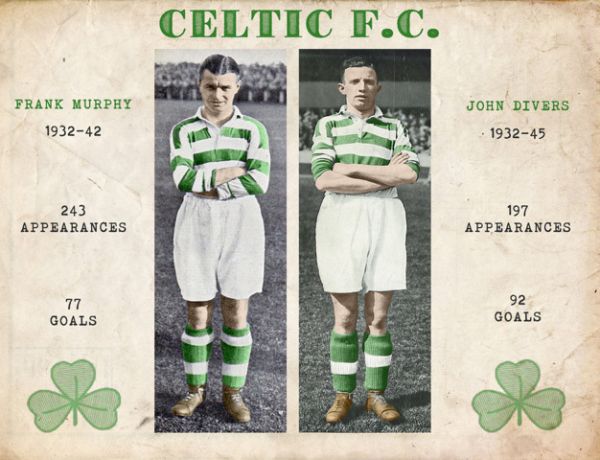
Name: JOHN DIVERS
Born: August 6 1911
Died: June 8 1984
Appearances: 197
Goals: 92
Scottish League medals: 1937/38
Scottish Cup medals: 0
Glasgow Cup medals: 1938/39
Glasgow Charity Cup medals: 1936/37, 1937/38
Scotland Caps: 1
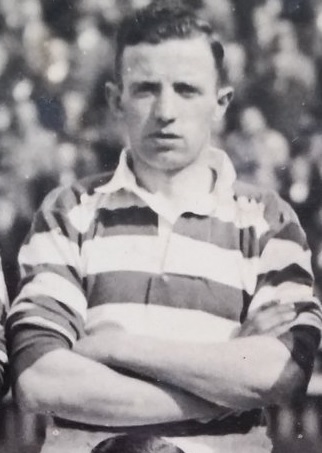
John Divers, Celtic in the Thirties. Photo The Celtic Wiki
There have been three men of the name John Divers who have played for the club. The pronunciation of the name is somewhat contentious. To pronounce Divers as if it rhymes with “rivers” is possibly the correct and preferred way; however most fans pronounced the name as if they were talking about deep sea divers.
The first John Divers in the 1890s (heavily involved in the players’ strike of 1896) has no known connection to the other two, who were father and son. Father played in the 1930s, but son played less successfully (although not without his moments) in the 1960s. It is probably true that the Second World War affected John Divers II more than most players, but, as he himself would admit, it would cause a lot more damage to people other than himself, and not just in football careers.
Celtic in the Thirties
John was born in Clydebank in 1911. He was extremely well connected in Celtic circles in that his mother was Marjory Gallacher, frequently referred to a Madge, and she was the sister of no less a player than Patsy Gallacher. So “football in his blood” was as true of Divers as it was of anyone else, but as so often happens in such circumstances, comparisons were odious and unfair. After all, who was likely to be as good as Patsy Gallacher?
John grew up in difficult times playing for a variety on Juvenile and Junior teams in the Clydebank and Renfrew area, and was considered good enough to be called up to Celtic in early December 1932.
Celtic in the Thirties
Celtic in the Thirties – Volume One
Celtic in the Thirties – Volume Two
Celtic in the Thirties – Volume Two
Celtic in the Thirties
Yet although he seemed to have all the attributes in theory with a long stride and loose limbs, John took a long time to break through, causing Maley to wonder whether he was taking the game seriously enough, and to wonder whether a move to England would not be a better idea given the amount of family pressure and expectations put on his shoulders by Uncle Patsy and others.
He had a few games as a cover for injuries in the successful Celtic team of 1936 and 1937, (including the winning of Glasgow Charity Cup final against Queen’s Park in 1937) but he did not really break through until autumn 1937 when McGrory retired. Crum now moved to the centre forward position and Divers stepped up to the inside left position.
Round about the same time, Willie Buchan went to Blackpool for £10,000 and he was immediately replaced by Malcolm MacDonald. This almost seamlessly the forward line of Delaney, Buchan, McGrory, Crum and Murphy morphed into the equally good Delaney, MacDonald, Crum, Divers and Murphy – such was the apparently endless stream of talent that McMenemy, trainer in theory but manager in practice, was producing for the club.
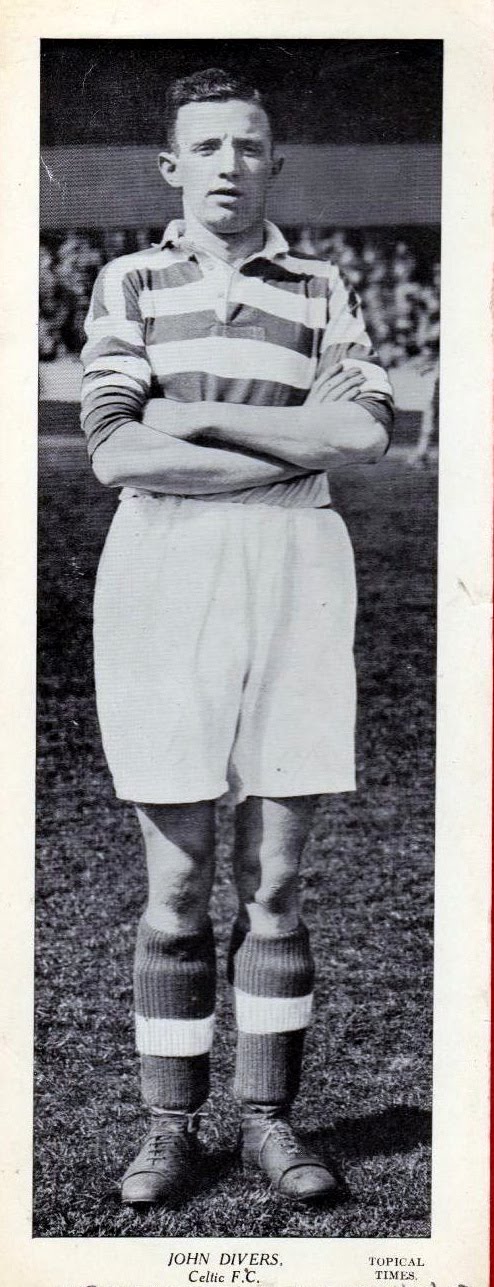
John Divers, Celtic in the Thirties. Photo The Celtic Wiki
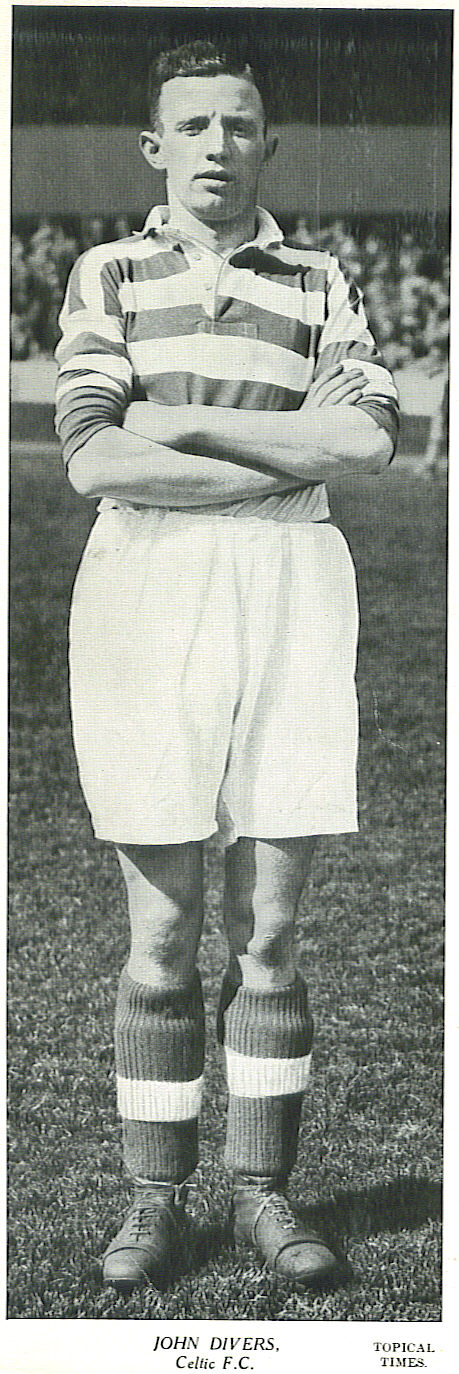
John Divers, Celtic in the Thirties. Photo The Celtic Wiki
Celtic in the Thirties
The instructions for this fine footballing side were minimal. “Just go out, play football, use your brains and enjoy yourselves” were the team talks and Divers, walking into an already successful forward line enjoyed himself immensely with so many good players around him, and within a very few months, he was looked upon as one of the stars of that side.
He announced himself with two great games at the festive period. He scored twice on Christmas Day as Kilmarnock (and their new Manager Jimmy McGrory were torn apart 8-0) and then twice again on New Year’s Day in what was believed to be a record crowd for Celtic Park as Rangers were dished a 3-0 thumping. One of his goals was described as being as “good as anything ever seen at Celtic Park” – and that is saying something.
From then on in 1938, apart from a Scottish Cup defeat to Kilmarnock which no-one could understand, the team won more or less every game, winning the Scottish League with a degree of ease, then the Glasgow Charity Cup and finally, the greatest triumph to date, the Empire Exhibition Trophy in which Divers is often described as being the man of the match in several games as English giants like Sunderland and Everton were defeated, and Celtic clearly established themselves as the champions of Great Britain. He is frequently referred to as the brains and the creative power of that wonderful forward line.
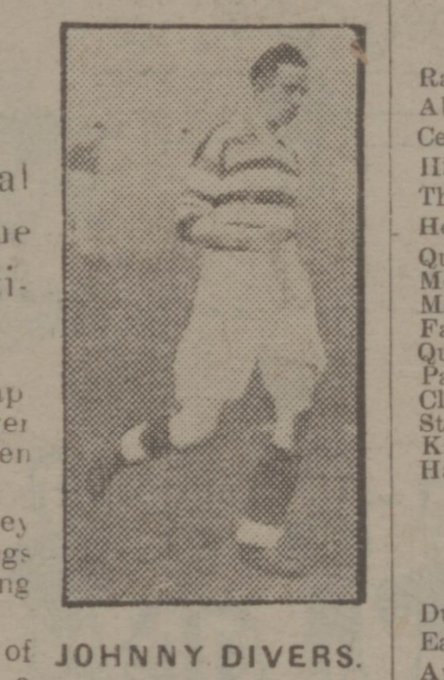
John Divers, Celtic in the Thirties. Photo The Celtic Wiki
Celtic in the Thirties
Such form naturally brought International recognition. John was one of four Celts chosen to play for Scotland against Northern Ireland in Belfast in October 1938 and he played well, also winning his first ever Glasgow Cup medal at about the same time. He might have won more Scotland caps – he was certainly playing well enough to deserve more – but his form did shade a little in the general decline of the team in the last season before the war.
Things were of course never the same again after that with a new Manager in Jimmy McStay, and a new set-up compelled by the restrictions of the war. John had to work in the shipyards as well as play football, and it wasn’t always easy to combine the two of them. Training was difficult, and even on a Saturday when football was allowed, he had to do a shift in the morning and was frequently seen (as were other players) arriving at a ground in his overalls and working clothes.
Celtic in the Thirties by Matt Corr
Click on image above to order Celtic in the Thirties by Matt Corr, Volumes One & Two, Published by Celtic Star Books, Image The Celtic Star
Celtic in the Thirties
He did keep playing for Celtic for a while and then, like quite a few other players, he was loaned out to Morton (possibly because it was easier to reach Greenock than it was to get across the city to Parkhead) and he never came back to Celtic, being offered a free transfer at the end of the war.
He was not quite finished, and kept returning to Morton and giving teams like Celtic a hard time of it. Possibly some of his dealings with the tyrannical Maley in the 1930s had rubbed off on him, for he involved himself in the Players’ Union and indeed at one point became its Chairman!
He died in 1984 having seen the Lisbon Lions, and also having the satisfaction of seeing his son of the same name of himself playing for Celtic as well. In truth the father was a better player than the son, but the son has the distinction of being the man who on August 25 1965 scored the first goal of Celtic’s nine in a row!
David Potter